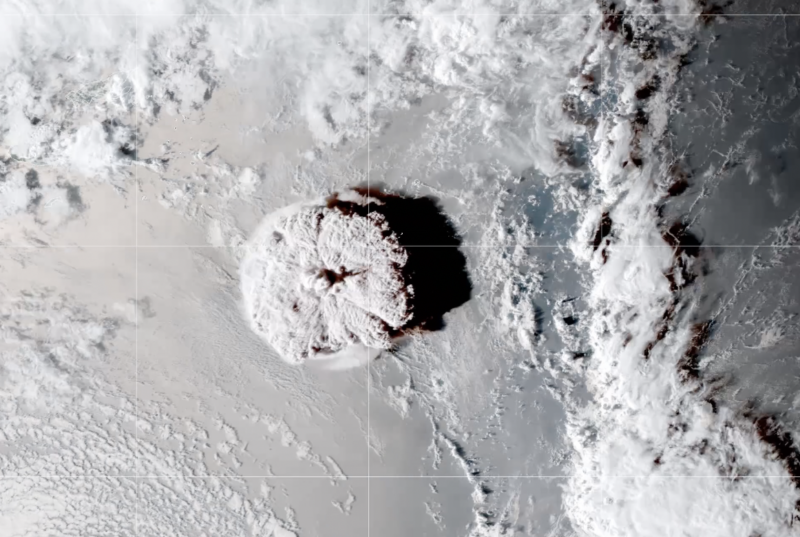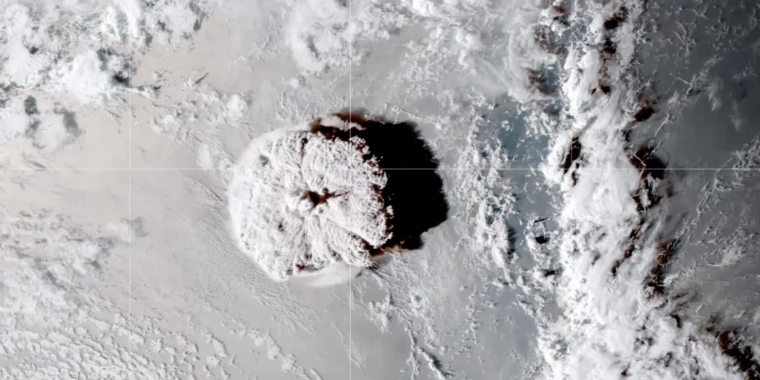
In January this year, an undersea volcano in Tonga produced a massive eruption, the largest so far this century. The mixing of hot volcanic material and cool ocean water created an explosion that sent an atmospheric shockwave across the planet and triggered a tsunami that devastated local communities and reached as far as Japan. The only part of the crater’s rim that extended above water was reduced in size and separated into two islands. A plume of material was blasted straight through the stratosphere and into the mesosphere, over 50 km above the Earth’s surface.
We’ve taken a good look at a number of past volcanic eruptions and studied how they influence the climate. But those eruptions (most notably that of Mount Pinatubo) all came from volcanoes on land. Hunga Tonga may be the largest eruption we’ve ever documented that took place under water, and the eruption plume contained unusual amounts of water vapor—so much of it that it actually got in the way of satellite observations at some wavelengths. Now, researchers have used weather balloon data to reconstruct the plume and follow its progress during two circuits around the globe.
Boom meets balloon
Your vocabulary word of the day is radiosonde, which is a small instrument package and transmitter that can be carried into the atmosphere by a weather balloon. There are networks of sites where radiosondes are launched as part of weather forecasting services; the most relevant ones for Hunga Tonga are in Fiji and Eastern Australia. A balloon from Fiji was the first to take instruments into the eruption plume, doing so less than 24 hours after Hunga Tonga exploded.
That radiosonde saw increasing levels of water as it climbed through the stratosphere from 19 to 28 kilometers of altitude. The water levels had reached the highest yet measured at the top of that range when the balloon burst, bringing an end to the measurements. But shortly after, the plume started showing up along the east coast of Australia, which again registered very high levels of water vapor. Again, water reached to 28 km in altitude but gradually settled to lower heights over the next 24 hours.
The striking thing was how much of it there was. Compared to normal background levels of stratospheric water vapor, these radiosondes were registering 580 times as much water even two days after the eruption, after the plume had some time to spread out.
There was so much there that it still stood out as the plume drifted over South America. The researchers were able to track it for a total of six weeks, following it as it spread out while circling the Earth twice. Using some of these readings, the researchers estimated the total volume of the water vapor plume and then used the levels of water present to come up with a total amount of water put into the stratosphere by the eruption.
They came up with 50 billion kilograms. And that’s a low estimate, because, as mentioned above, there was still water above the altitudes where some of the measurements stopped.
Not like the others
Eruptions like that of Mount Pinatubo put lots of reflective sulfur dioxide aerosols into the stratosphere, and these reflect sunlight back into space. This had the net effect of cooling surface temperatures over the years immediately following the eruption, although the material gradually fell back through the atmosphere, causing the impact to fade out over several years. At least in its immediate aftermath, Hunga Tonga doesn’t seem to have produced a similar effect.
Instead, the water vapor was acting as a greenhouse gas, as you’d expect. This meant that energy was absorbed by the lower region of the eruption plume, leaving the upper parts cooler by about 2 Kelvin.
The researchers suspect that the huge amount of water in the eruption proper kept a lot of the sulfur dioxide from ever reaching the stratosphere. And material that did make it to altitude probably got washed out faster. The researchers also suspect that the changes to stratospheric chemistry may influence the amount of ozone present there, but that may take longer-term monitoring to resolve.
Overall, the conclusion seems to be that it really makes a big difference when an eruption takes place under water. Eruptions like Hunga Tonga are going to be rare in comparison to land-based eruptions, because the eruption has to take place in relatively shallow water in order to blast material all the way to the stratosphere. But when they do occur, it seems like everything from the atmospheric chemistry to the climate impacts are likely to be distinct.
Science, 2022. DOI: 10.1126/science.abq2299 (About DOIs).








